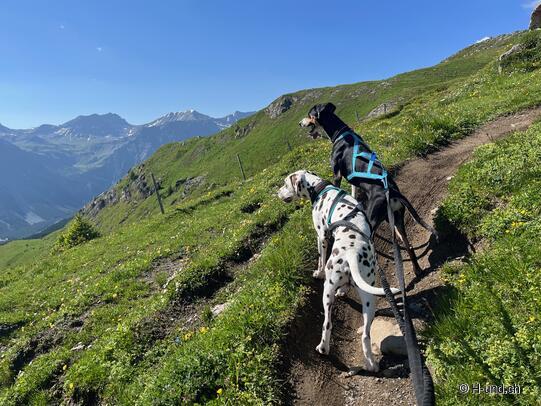Fit for the hiking season
Preparation with your dog
The new hiking season is just around the corner and with it new adventures outside with our dogs! Of course, we also want fit four-legged friends at our side. In this article, you'll find out what it takes and how you can prepare your dog ideally for the upcoming hiking tours.

Contribution from Andrea Norinelli/Physiotherapist Animactive
Set realistic goals
All of us have different ideas and preferences for the hiking season: some enjoy a quiet 2-3 hour hike, others love the really long tours and still others prefer technical routes in the high mountains. Not to forget that our dogs are also very different and have different needs and possibilities depending on their breed, state of health and age.
An important point is therefore to decide individually for each dog-human pair what we want and what we can do. After all, nobody will be happy if they like to be out and about for 7-8 hours but their dog can't do this (age, health, etc.). As a human, you also have to take a step back and decide in the interests of your dog.
A realistic assessment is therefore fair to everyone involved so that everyone can enjoy the hikes.
Condition building
Over the dark and cold months, some people may have done a little less with their dogs and so it may be that our four-legged friends' fitness has diminished somewhat at best. Generally speaking, our dogs' fitness is well maintained and builds up again much faster than that of us humans.
Nevertheless, especially if long trips are planned, it can make sense to slowly get your dog used to longer distances again so that they don't have to go from 0 to 25 kilometers straight away.
Health requirements
In addition to the annual check-up at the vet's vaccination appointment, it is generally recommended that you also take your dog to a physiotherapist once or twice a year. This allows certain issues to be identified at an early stage and remedied accordingly so that our four-legged friends stay fit for as long as possible.
Hiking requires both well-trained muscles and good coordination in dogs. Especially in more technical terrain, this gives the dog more support and uneven surfaces can be better compensated for. There are countless ways to prepare our dogs in everyday life so that muscles and coordination can be promoted. Contact your physiotherapist or dog school for tips and tricks.
Material check
There are now countless types of harness on the market: pulling harnesses, safety harnesses and special hiking harnesses with handles on the back to support the dog. What the dog needs depends on the requirements and the planned hikes. However, it is advisable to have the harness checked by a good specialist (physiotherapist, specialist store) at the beginning of each season to ensure that it still fits properly.
Before the hiking season, it is also the right time to check all the other equipment you may need. This could be booties, collapsible boots or special lines or harnesses. This ensures that everything is ready before the first hike and you can just set off.
Familiarization and education
A hike not only requires the dog to be physically fit, but also to be well trained and accustomed. A hike can be a sensory overload, especially for young dogs who don't know much yet. Eating in restaurants, encounters with large crowds or even cows or other animals can be practiced well in everyday life. Dog encounters should also be practiced in normal everyday training so that unpleasant situations do not arise on a narrow hiking trail.
There may always be a situation on a hike that the dog is not familiar with, has to overcome or briefly reaches its limits. But if you have worked on the basics beforehand and the dog has already been exposed to similar situations, it will be able to master new challenges and react to them more calmly.
A relevant topic in this context is the leash: in many cantons, a leash is mandatory during the spring to early summer months. Outside of this period, it is recommended that you only let your dog off the lead if the recall works. This should be even more important for dogs that hunt.
After the hiking season is before the hiking season and there are so many things we can do during this time so that our dogs are ready when spring comes around again. Whether it's a health and equipment check, targeted muscle, endurance and coordination development, everyday training and education and, of course, the best part: planning new hikes and tours with our four-legged friends! So we can be well prepared and enjoy a great day out in nature with our dogs.




